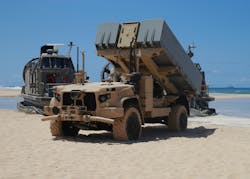Marines ask Oshkosh for unmanned combat vehicles as launchers for anti-ship missiles in beach defense
QUANTICO MARINE BASE, Va. – U.S. Marine Corps expeditionary warfare experts are asking Oshkosh Defense LLC in Oshkosh, Wis., to provide unmanned armored combat vehicles as mission launchers for a new Marine Corps land-based anti-ship missile system.
Officials of the Marine Corps Systems Command at Quantico Marine Base, Va., have announced a $23.7 million contract to Oshkosh for Remotely Operated Ground Unit for Expeditionary Fires (ROGUE-Fires) carriers for use in the Navy/Marine Expeditionary Ship Interdiction System (NMESIS).
The ROGUE-Fires long-range anti-ship missile launchers will be based on unmanned remotely operated versions of the Oshkosh Joint Light Tactical Vehicle (JLTV), each which will carry two Naval Strike Missiles (NSM) to help protect Marine Corps infantry on invasion beaches.
NMESIS will provide the Marine Corps High Mobility Artillery Rocket System (HIMARS) battalions with anti-ship capabilities. NMESIS integrates a Naval Strike Missile (NSM) launcher unit, capable of launching two NSMs, onto a ROGUE-Fires carrier.
The NSM has an imaging infrared seeker, an onboard target database, and navigates by Global Positioning System (GPS), inertial sensors, and terrain-reference systems. It can detect, recognize, and discriminate among targets independently, and is designed to strike enemy ships at or near the water line to inflict maximum structural damage.
Raytheon is building the NSM in partnership with Kongsberg Gruppen in Kongsberg, Norway. In addition to NMESIS, the missile is to equip the littoral combat ship and FFG(X) future frigate with stand-off surface-to-surface weapons capability.
Raytheon and Kongsberg in their initial OTH-WS bid offered the Naval Strike Missile (NSM) -- a fifth-generation long-range, precision-strike missile that offers strike capability against heavily defended land and sea targets. NSM is a modernized version of the Norwegian Penguin anti-ship missile.
Experts from the Marine Corps and Raytheon tested the NMESIS off the coast of California in April 2021. The ROGUE Fires vehicle is remotely operated using the teleoperator or leader-follower modes. It was built for the Marines to support anti-ship operations from the ground.
The ROGUE Fires version of the JLTV lacks a crew cab and body, and is integrated with sensors and cameras, with a launcher mounted on top of the vehicle. Marine Corps leaders say they plan eventually to launch future weapons from ROGUE Fires.
On this contract Oshkosh will do the work in Alexandria, Va.; Gaithersburg, Md.; and Oshkosh, Wis., and should be finished by November 2023. For more information contact Oshkosh Defense online at https://oshkoshdefense.com, or Marine Corps Systems Command at www.marcorsyscom.marines.mil.
About the Author
John Keller
Editor-in-Chief
John Keller is the Editor-in-Chief, Military & Aerospace Electronics Magazine--provides extensive coverage and analysis of enabling electronics and optoelectronic technologies in military, space and commercial aviation applications. John has been a member of the Military & Aerospace Electronics staff since 1989 and chief editor since 1995.
